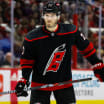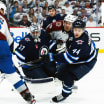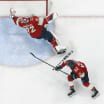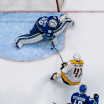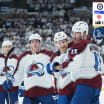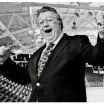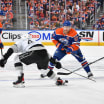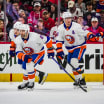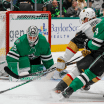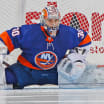Dan Craig knows exactly what was going through his mind the instant photographer Dave Sandford snapped a picture of him at the first NHL Winter Classic on Jan. 1, 2008, one of the most important days in NHL history.
Craig is sitting rinkside on a chair, his frigid, swollen and numb hands covered by a towel. He's looking up at the 71,217 fans watching the Buffalo Sabres play the Pittsburgh Penguins on a makeshift rink built under his supervision inside Ralph Wilson Stadium, home of the National Football League's Buffalo Bills.
2008 NHL Winter Classic: An oral history
Key figures share stories behind inaugural game in snowy Buffalo
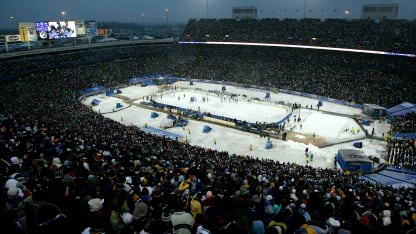
© Claus Andersen/Getty Images
"I am looking around and just saying to myself, 'This is huge.' " I'm saying it over and over to myself. 'This. Is. Huge. This. Is. Huge,' " said Craig, the NHL's vice president of facilities operations. " 'This is beyond anything that we can comprehend. And this is going to be absolutely gigantic.' "
He was right.
The Winter Classic, held on that beautifully cold and snowy New Year's Day in Buffalo, has become the signature event on the League's regular-season calendar. It's a holiday hockey celebration, the game played in its original, most rustic form under the cover of the sky, with grown men acting like boys, some reliving their days on the ponds and backyard rinks.
The Sabres will celebrate the 10-year anniversary of that game by playing the New York Rangers in the
2018 Bridgestone NHL Winter Classic
at Citi Field in New York on Jan. 1 (1 p.m. ET; NBC, SN, TVA Sports, NHL.TV).
Since that day in Buffalo, the Winter Classic has been played in eight more venues, some iconic like Wrigley Field in Chicago (2009), Fenway Park in Boston (2010) and Michigan Stadium on the campus of the University of Michigan (2014), where the League set an attendance record of 105,491.
The Winter Classic will be played at the
University of Notre Dame's football stadium
in 2019.
The success of the Winter Classic has sparked events like the Coors Light NHL Stadium Series, which has been played coast to coast, from New York to California and in between in Denver, Minneapolis and Chicago. It has led to the reboot of the NHL Heritage Classic, the League's initial regular-season outdoor game, first played in Edmonton in 2003.
Two outdoor games, the 2017 Scotiabank NHL Centennial Classic in Toronto on New Year's Day and the
2017 Scotiabank NHL100 Classic
in Ottawa on Dec. 16, bookended the NHL's Centennial celebration this year.
"We hear from the teams in Florida, the team in Arizona, the team in Texas," NHL Commissioner Gary Bettman said. "They all want to host an outdoor game."
None of it would have happened without the gargantuan success of the first Winter Classic, which had everything, including Penguins captain Sidney Crosby, then in his third NHL season, pushing the puck through the snow to score the game-deciding goal in the shootout for a 2-1 win.
Here is the definitive oral history of how the Winter Classic came to be and what made Jan. 1, 2008, in Western New York so unique, and such a game changer for the League:
THE BEGINNING
Jon Miller, NBC Sports president of programming: We had acquired in the fall of 2004 the rights to the NHL beginning in the 2005-06 season. Remember, earlier that October in 2004, the [Boston] Red Sox came back to beat the [New York] Yankees in the American League Championship Series after being down 3-0. I was looking for something unique and different to help us kick off our NHL programming. The idea was let's get the Boston Bruins to come down to Yankee Stadium and play the New York Rangers on New Year's Day, Jan. 1, 2006.
Commissioner Bettman: We couldn't do that because the old Yankee Stadium wasn't winterized and we couldn't get it winterized and it didn't justify the expense. It wasn't an option.
Miller:And, by the way, I had gone to the Yankees and they basically laughed me out of their offices when I brought up the idea. Then, in the fall of 2006, (former chief operating officer) John Collins joined the NHL. I said, 'Help me push this idea of an outdoor game.'
Commissioner Bettman:I thought the idea was somewhere between exciting and audacious.
Miller: I remember in the spring of 2007, during the Stanley Cup Playoffs, John [Collins] and I went and had lunch. He said, 'I've canvassed the League and we've only been able to find one team that indicated an interest in hosting this game. It's the Buffalo Sabres.' I said, 'Sold.' I said we'll make a big deal out of this kid Sidney Crosby and Pittsburgh is not that far away from Buffalo, so let's give it a shot.
Commissioner Bettman: There were a series of hurdles that we had to get through. Did we have the capability to build it out and create a rink and the surrounding environment that was suitable for an NHL game that counted? Would we find a sponsor to name it? We did. It was AMP Energy. We had to sell 72,000 tickets to make it a big deal because we didn't want to be embarrassed if it didn't sell out. We put the tickets on sale and they sold out in 20 minutes.
Miller: I thought initially it would be a novelty. Little did I ever imagine it would become something as big as it's become.
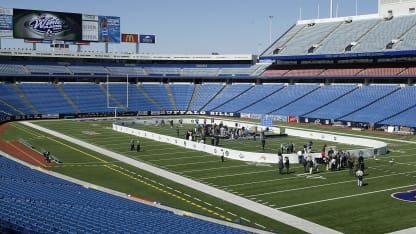
© Rick Stewart/Getty Images
MAKING A HOCKEY VENUE
Craig: We arrived [Dec. 23, 2007], the day of a game between the Bills and New York Giants, and we wanted to start immediately after the game. The wind picks up at night and we try to put the tarp down to get started, and Mother Nature just said, 'Nah, I don't think so, not tonight.' We had tarps, people, things basically flying everywhere. The production schedule we put together for eight days only had 18 hours of buffer time written in. The very first night we used 12 of our 18 extra hours. We couldn't do anything. It was too dangerous.
Bill Miller, NHL vice president of planning events: Dan Craig had serious concerns about the ice and if you watch the tape of the game he's spending half the game pounding snow into that one spot, but the rest of us, we didn't know enough to think we couldn't do it. So, the whole week we were like the Little Rascals basically saying, 'Let's put on a show.' It was brand new to us so we all had goofy smiles on our faces the whole time.
Craig: I worked the whole thing with shingles. Honest, I couldn't put a razor to my face. There were many times when I would go back through security at 1 or 2 o'clock in the morning and I would have a lotion that I would put on. For me, I would just rub it in and I wouldn't even look until I looked in the mirror driving over there and I had ointment all over my face. I had the shingles from my eye right down to the middle of my chin. It was all stress related.
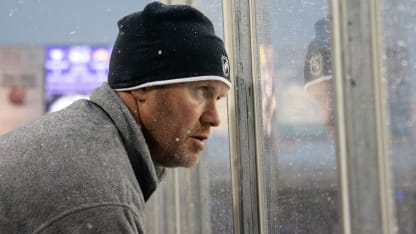
© Bill Wippert/Getty Images
Bill Miller:The hardest part of it for us in events was turning a football locker room in an older stadium into a hockey room. There are real basic differences in the functions of the rooms. The home room was nice. The visiting room was really substandard, so we had to cover carpets and anything metal so nobody's skates got messed up. We also had to get the trainers for each team to buy into the fact that we were going to take care of them. They were like, 'What are you getting us into?' We made a couple of trips to Pittsburgh to show them drawings to make sure they were comfortable and show them that at the end of the day we're putting on a hockey game and we know what you need. I think they were thinking they were flying into some circus, but once they got there they were very pleased that we did listen to what they wanted and we were able to provide them with what they needed to play a game.
Craig: On my end, I would be very fortunate to get four hours of sleep a night and the sleep would happen at weird hours because I would be at the rink at weird hours. I would try to determine when I could leave and when I couldn't leave, and when I'd have to be back. There were many days when people would leave, come back and I was still there. That's just the way it was. The contractor that we had, the crew, everybody left at the same time. You just can't imagine. It's like, 'Uh, guys, we need shifts of people, we don't need everyone leaving at the same time.' We have the best players in the world and I can't have anything other than the best effort that I can put forward. It was a struggle every single day.
Commissioner Bettman:None of this would have worked without Dan. We have the world's leading ice maker.
Bill Miller: New Year's Day we all were feeling like, 'We got this, we got this.' [NHL vice president of events] Chie Chie [Yard] and I each had a team. I had the Penguins and she had the Sabres. We each led our team out of the dressing rooms. So, I'm walking in front of them, we come out of the visiting locker room and as soon as we got on the field you hear the 71,000 people. The little hairs on my arms were standing up, and I'm just working on the event. The players, you could see them all looking around like, 'Whoa.' They were like little kids. It brought out the joy in them and I think it did for us too.
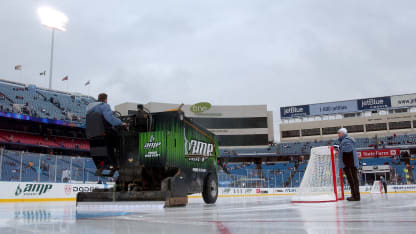
© Dave Sandford/Getty Images
THE GREAT BUFFALO TAILGATE
Colby Armstrong, Penguins forward: Driving up to the game, people were outside tailgating and we never see that in hockey game unless you're in Carolina. I thought that was just so cool coming to the game with the wintry scene and hockey fans in the parking lot.
Lindy Ruff, Sabres coach: It was really like going into a football game. I thought we'd see a fair gathering, but it was an incredible gathering. I don't know if it was snowing at the time, but it was cold. Didn't matter. The people were going to enjoy that time in the parking lot.
Chris McKenzie, 32-year-old Sabres fan living in Vancouver who attended the game: We were one of the first buses to arrive that morning, after leaving Southern Ontario around 7 a.m. We stepped off the bus to start the long tailgate those parking lots are famous for and it was evident right away it was going to be a day to remember.
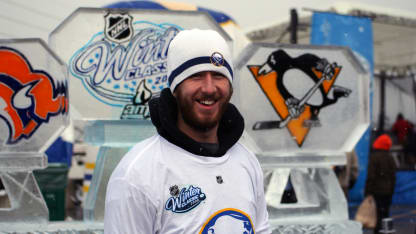
Rob Sanderson, 31, from Rochester, New York, who was at the game with his father: Buffalo felt a real sense of pride to be selected to host the event. What added to all the excitement was the fact that the tailgates were taking place hours after New Year's parties. I know some people came straight from their party to the tailgate, and it was blatantly obvious that others had as well.
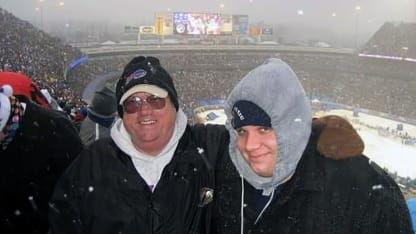
Pat Sajak, host of TV's "Wheel of Fortune," a big hockey fan who attended the game:We actually flew up there just before the game and went directly to the game. It took my breath away. The stadium looked like one of those Christmas snow globes.
Jon Sherman, 26-year-old Sabres fan from Williamsville, New York who attended the game: Walking out of the tunnel to my seats, I got that feeling you get walking into a new venue for a sporting event. You're just in awe and feel like a kid again. It was a scene I had never seen before. It was pretty cool.

Brian Campbell, Sabres defenseman:You come out for warmups and see four Buffalo fans with no shirts on and you're like, 'This is awesome.'
Commissioner Bettman: I remember walking into the stadium, it was snowing and I'm looking around and I see all these people in this huge stadium and the hair stood up on the back of my neck, like, 'Holy cow.'
THE UNIQUE BROADCAST
Sam Flood, coordinating producer of NBC Sports:[On] 'Sunday Night Football' they always use an airplane, so we went with the airplane for replays. We had a shooter that knew how to do it and we knew it would be a very different look. We wanted to have a bigger sense of place and thought it was more valuable than just a cable cam. We all talked about how to make the show look bigger and capture the grandness of it. That was the solution.
Darren Pang, NBC's between-the-benches analyst for the game: I was presenting something to the Phoenix Coyotes at the time where I was going to put skates on between the benches and do an interview on the ice during the warmup. I had this conversation with Sam Flood and I told him that I was going to do this thing with the Coyotes. He said, 'Hold on to that. That's a great idea.' So, I brought my skates and I got to interview (Sabres goaltender) Ryan Miller in the warmup. I don't know if that had ever been done before. It was just so cool.
Flood: I remember when the first goal was scored the replay sequence, we went to a couple of normal replays and the third look we went to the airplane. Someone in the truck starts yelling, 'You can't see the puck go in the net! You can't see the puck go in the net!' And I said, 'That's the point.' No one had ever seen a replay from an airplane before at a hockey game. It was special and different. A cloud floated in just as the puck was about to go in the net, but it was too cool. It wasn't about what you're seeing but how you were seeing it.
Ruff: Watching the game back, some of the on-ice camera angles, like that camera through the boards that we hadn't seen, gave it such a cool look.
Flood: Perhaps the most essential thing was the decision made the day before. Mike 'Doc' Emrick didn't like being up in the football booth because he didn't think he saw enough, so we moved out the camera position that was supposed to be for a low center-ice camera and put Doc and Eddie [Olczyk] on that platform to call the game. That ultimately captured the essence of being out in the elements more than anything else because there was Doc, with his meticulous notes, holding them in his hands and all the colors he had for each team, each player, each nugget, those five or six different colors just ran together. We put Doc and Edzo on camera multiple times throughout the game because of the snow swirling and the visual from where they were. The pure joy both men had from being in the elements, it created unbeatable television.
Pang: I had my wireless mic, which I kept the whole time. I did not put a headset on because I wanted to be mobile. So, in the first commercial break I went on the ice and I put a snowball together. I looked up at Doc and Edzo and I threw the snowball toward them to give them an idea how much snow was being built up.
Flood:The moment that we knew it was something different was when Bob Costas got back from it and was at the theater the next night and he said he had more people stopping him to say, 'God, I loved that Winter Classic.' He said he'd never been touched more times by people who wanted to talk about witnessing an event on television. That spoke volumes about what we had accomplished on that day.
THE GAME
Jordan Staal, Penguins forward:There were pinch-me moments throughout. After you finished a shift you just looked around really and you started realizing where you're at and how cool it is.
Sajak:They were little boys out there.
Ruff: We talked about how we just had to be pretty simple with that amount of snow, the fact that the puck was going to stick, that you wouldn't be able to carry it. If you got caught looking up to make a pass there's a good chance the puck was going to be 4 feet behind you.
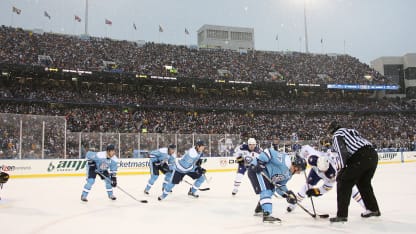
© Bill Wippert/Getty Images
Armstrong, who gave the Penguins a 1-0 lead 21 seconds into the first period:On my goal, I just remember Crosby getting it through the neutral zone, literally just like pushing it through people, driving wide to the net and cutting right in. I don't even know how it got through there. Maybe we got lucky because it was early in the game and the snow hadn't piled up as bad, but it was just a garbage goal to pile in there 21 seconds into the game.
Ruff: Brian Campbell was the guy that got beat on the first goal. He probably doesn't want me to mention that, but I'm going to.
Campbell:Of course Lindy says that. I think it was early in the game, kind of wide, got beat and they got a rebound and put it in.
Ruff: When Campbell scored (at 1:25 of the second period to tie the game 1-1), it was like the cheer was almost delayed a second. It was kind of a funny reaction. Once it went in and everybody knew, the magnitude of that noise coming from the amount of people there, it made you wish you could have had five or six goals in that game.
Campbell:You don't have the goal horn going off right away and the sound just takes a little longer to travel. But then you look out and see what's going on in the stands, see everybody jumping around. It was a weird feeling, but pretty exciting.
Ty Conklin, Penguins starting goalie: The pace of the game was fine, but it was probably just difficult to make crisp plays and handle the puck, just in tight.
Pang: I remember seeing was an issue. Guys went from a clear visor to a tinted visor to now they're taking off their visors. Crosby said to me something like, 'I can't see, I need windshield wipers.' I passed it along on the air.
Staal: I had no visor so that was maybe an advantage for me. I don't remember it being crazy bothersome for the eyes, but I do remember the puck slowing down a bit and not being able to shoot was a little bit of an issue.
Pang: Dan Craig was fixing a hole during the first commercial break.
Craig:What hole? Which one? There were only six. [Laughs]
Crosby:Being outside, I think we knew that might be the case.
Craig: All of it backs up to our installation with our contractors. When I started building ice I could see a ridge and that ridge is the thing that haunted me that whole game. It was all the way down the benches, parallel to the benches. It was that whole ridge line that created an issue. It went all the way from one end of the rink to the other end.
Campbell:All I am thinking as I sat there watching [Craig] fix these patches with his bare hands was, 'What is this guy made of?' I'm like, 'How is this guy's hand not completely numb?'
Craig: I made sure we had slush available and made sure we had carbon dioxide available. The first time I went out there it was like, 'OK, let's put this thing back together.' The second and third time I was just telling people to take all the ice chips out of there, grab some good slush, some CO2, get it down in there, pound it in and get it hard, and hopefully we survive.
Commissioner Bettman: I was concerned.
Don VanMassenhoven, one of the two referees: Dan Craig and his crew were coming out on every stoppage. The ice was playable, but they had to work and he worked incredibly hard. But nobody was complaining.
Craig:I had time on ice in that game too. I'm fixing a hole at the far end. The crew had gone off and I was finishing with something. I can't even remember what I had in my hand. They dropped the puck in the other zone and I closed the gate at the very same time VanMassenhoven went by.
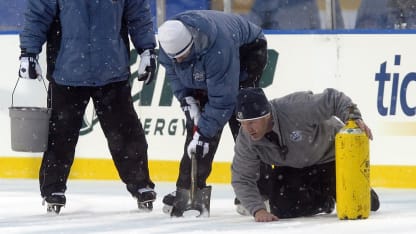
© Dave Sandford/Getty Images
VanMassenhoven:Nobody saw him down on that end and that was comical. He was out there a lot. He was out on his skates. He was everywhere. He was a machine.
Craig: On the very last one, when I had to bring out the big cylinder down at the far end, I remember Sid coming by me and he said, 'You are doing an absolute fantastic job with this today. I want to thank you for that.' He gave me a little tap and away he went.
Ryan Miller: The way the stadium is set up, the wind just comes down the field. The kickers in football talk about [it]; if you're in Buffalo and you've got the wind, if you're kicking that way, you're in trouble. We had to switch ends [at the 10-minute mark of the third period] to make it fair. You don't want to be against the wind more than the other team. It was kind of funny that we had to consider all that.
Armstrong: I took a penalty right at the end of regulation, so I'm in the box to start overtime. I'm like, 'Oh my God, what a terrible way to end it, a terrible way to go out.' I'd be the guy who got a goal and then ended up costing our team the game on a (hooking) penalty. I think it helped that the ice wasn't great and it wasn't your standard, usual power play. And then everything you could have hoped for in the game happened for the NHL. The face of the League, the superstar, Sidney Crosby, gets his chance to win the game (in the third round of the shootout).
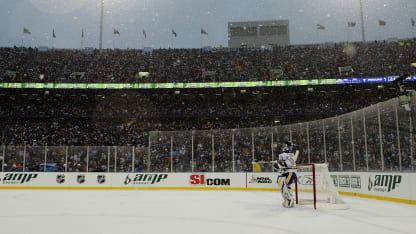
© Dave Sandford/Getty Images
THE SHOOTOUT
Marc Joannette, who officiated the game with VanMassenhoven: We kept the shootout at one end because we had to try to keep the snow off the ice at the same time. It was coming down pretty hard. Then, you see Sidney Crosby coming up the ice and Ryan Miller trying to cover the net. You could see the snow coming over the puck as he was coming down the ice.
Crosby:Just to get a shot off [is all I was thinking].
VanMassenhoven:The snow was billowing over his stick as he's pushing it and I literally had a thought in my head, 'Oh my God, what if this puck stops?' In the rulebook, if the puck stops on a penalty shot the shot is over. I don't know what would have happened if that had happened.
Joannette: There is no (video) review back then either, especially outside. And there was so much snow.
Crosby:You can barely see the puck on your own blade. Wasn't much of a move, but it was pretty hard for the goalie to see the puck too.
Ryan Miller: I think he actually lost the puck in the snow for half a second. I hesitated and I kind of waited. He picks it up cleanly.
Pang: Ryan Miller probably couldn't see the puck and was somewhat anticipating. Then, he moved first. As soon as he moved, it's in the net in a blink of an eye.
Joannette: I think he hit the net five-hole on that one.
Crosby:It was great to see it go in.
Staal: I remember talking, or yelling stuff after the game about how picture perfect it was and how happy the NHL would be. The right guy finished it off.
Armstrong: I've seen all the other games, but with him scoring that goal, the scene of him jumping around like a little kid, the snow falling, the fans going nuts, it couldn't have gone any better.
Flood: It will forever be the most significant outdoor game played.

